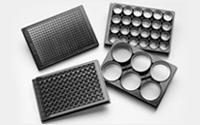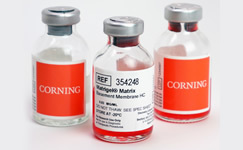 Corning 3D cell culture solutions: Rock the Science of 3D
Corning 3D cell culture solutions: Rock the Science of 3D

Why is 3D cell culture becoming so popular?
Cells grown in 3D more closely mimic in vivo behavior in tissues and organs than cells grown in a 2D culture model.
3D cell culture environments create more biologically relevant models for drug discovery which may lead to more predictive results, higher success rates for drug compound testing, a faster path to market, and reduced development costs.
For more than 25 years, Corning has delivered innovations that have advanced the science of 3D cell culture. Pioneering the development of novel tools providing easier access to in vivo-like 3D models, such as Corning Matrigel™ Matrix and Transwell permeable supports. And continue to support you with a diverse and evolving portfolio of innovative 3D cell culture products, like the Corning Spheroid microplate, as well as workflow solutions, protocols, and expertise.
Whether you’re just getting started in 3D cell culture, looking for proven ways to scale up, or moving to high throughput screening, Corning can help you break through the barriers to creating more in vivo-like environments and predictive models, working with you in critical areas like cancer biology, tissue engineering, and regenerative medicine – to help you bring safe, effective drugs and therapies to market in less time with greater certainty.
Following you will find selection of products for 3D cell culture applications like spheroid and organoid culture, in vivo tumor augmentation, cell migration and invasion, angiogenesis, and tumor invasion.

Elplasia™ Micro-Cavity Plates

Matrigel™ Matrix, ECMs and Scaffolds
